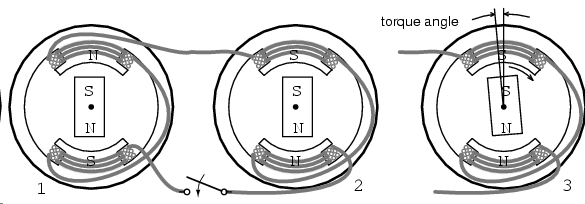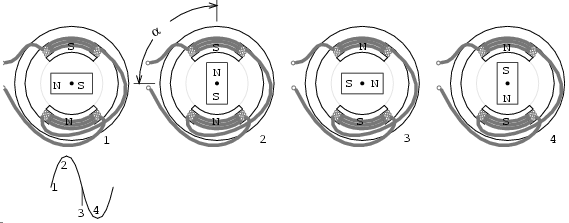Synchronous Motors
Synchronous Motors:Single phase synchronous motors are available in small sizes for applications requiring precise timing such as time keeping, (clocks) and tape players. Though battery powered quartz regulated clocks are widely available, the AC line operated variety has better long term accuracy-- over a period of months. This is due to power plant operators purposely maintaining the long term accuracy of the frequency of the AC distribution system. If it falls behind by a few cycles, they will make up the lost cycles of AC so that clocks lose no time.
Above 10 Horsepower (10 kW) the higher efficiency and leading powerfactor make large synchronous motors useful in industry. Large synchronous motors are a few percent more efficient than the more common induction motors. Though, the synchronous motor is more complex.
Since motors and generators are similar in construction, it should be possible to use a generator as a motor, conversely, use a motor as a generator. A synchronous motor is similar to an alternator with a rotating field. The figure below shows small alternators with a permanent magnet rotating field. This figure below could either be two paralleled and synchronized alternators driven by a mechanical energy sources, or an alternator driving a synchronous motor. Or, it could be two motors, if an external power source were connected. The point is that in either case the rotors must run at the same nominal frequency, and be in phase with each other. That is, they must be synchronized. The procedure for synchronizing two alternators is to (1) open the switch, (2) drive both alternators at the same rotational rate, (3) advance or retard the phase of one unit until both AC outputs are in phase, (4) close the switch before they drift out of phase. Once synchronized, the alternators will be locked to each other, requiring considerable torque to break one unit loose (out of synchronization) from the other.

Synchronous motor running in step with alternator.
If more torque in the direction of rotation is applied to the rotor of one of the above rotating alternators, the angle of the rotor will advance (opposite of (3)) with respect to the magnetic field in the stator coils while still synchronized and the rotor will deliver energy to the AC line like an alternator. The rotor will also be advanced with respect to the rotor in the other alternator. If a load such as a brake is applied to one of the above units, the angle of the rotor will lag the stator field as at (3), extracting energy from the AC line, like a motor. If excessive torque or drag is applied, the rotor will exceed the maximum torque angle advancing or lagging so much that synchronization is lost. Torque is developed only when synchronization of the motor is maintained.
In the case of a small synchronous motor in place of the alternator Figure above right, it is not necessary to go through the elaborate synchronization procedure for alternators. However, the synchronous motor is not self starting and must still be brought up to the approximate alternator electrical speed before it will lock (synchronize) to the generator rotational rate. Once up to speed, the synchronous motor will maintain synchronism with the AC power source and develop torque.

Sinewave drives synchronous motor.